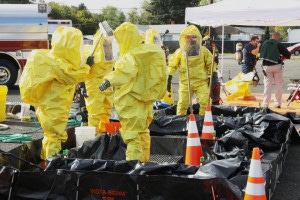Ammonia Risky Refrigerant? Leak Leaves One Dead in Boston
 In the last five years, anhydrous ammonia has become the go-to refrigerant for many companies — it’s cost-effective, efficient and free of the environmental impacts associated with CFCs and HCFCs.
In the last five years, anhydrous ammonia has become the go-to refrigerant for many companies — it’s cost-effective, efficient and free of the environmental impacts associated with CFCs and HCFCs.
Despite its many benefits, however, businesses must still treat this colorless gas with respect: Prolonged or large-volume exposure can result in serious injury or even death. That’s the unfortunate situation facing a Boston-area seafood warehouse after a 5000 pound ammonia leak occurred, killed one worker and forced a shelter-in-place order from Boston Police. Here’s what went wrong.
Check out this related content:
- Watch Ammonia as a Refrigerant Training Video
- Download our HVAC “Spring Cleaning” Checklists
- Search other ammonia-related articles
Ammonia Basics
The switch to Ammonia as a refrigerant makes sense: It’s 3-10 percent more efficient than CFCs, has a global warming potential of zero and building ammoina-based systems costs 10-20 percent less than a comparable CFC solution thanks to narrow-diameter piping. Gaseous ammonia has a distinctive smell which is detectable even at low concentrations and is lighter than air ,meaning it will rise and dissipate in the atmosphere.
Nonetheless, ammonia comes with a number of serious health risks. In high concentrations it can irritate or burn skin and leave permanent scarring and may also cause permanent blindness. If inhaled, ammonia not only causes severe throat and nose irritation but also a life-threatening accumulation of fluid in the lungs.
Emerging Problems?
On March 23rd, police and fire crews responded to an emergency at the Stavis Seafoods Warehouse — an ammonia breach in progress which dumped more than 5300 pounds of gas into the facility. For three hours emergency crews worked to shut off the main valve and restore neighborhood safety; despite their efforts, one worker was killed by the leak.
So what happened? According to news reports, problematic procedures may be to blame. For example, the plant was fined several years ago by OHSA for infractions related to its refrigeration system — workers did not receive annual emergency response training, no written respiratory protection plan was in place and equipment was not properly inspected.
Here’s the takeway: Compared to CFCs and HCFCs, ammonia is a safe and efficient alternative. But “safe” is relative — to ensure worker safety and regulatory compliance, regular inspections combined with clear emergency response plans are required. The same is true for any HVAC or refrigeration system; while deferred maintenance may not seem risky if all components are working as intended it takes only a single, sudden failure to property and lives in danger. Ongoing, scheduled evaluations and preemptive maintenance are critical for any ammonia storage solution — lax procedures damage more than the bottom line.
Next Steps:
- .Watch our Ammonia as a Refrigerant Operator Training Podcast.
- Subscribe to our blog to stay informed on the latest HVAC maintenance news and insight.
- Stay up to date on facility maintenance tools such as chiller tube cleaners,boiler tube cleaners andhose/pipe cleaners,descaler systems,test instruments,air duct cleaners,industrial vacuums,commercial pressure washers, and drain cleaners.


Leighton Wells
That’s absolutely terrible. So sorry to hear about that happening.
Ken dwyer
The concentration of ammonia is so much stronger than household ammonia , a leak is so strange because when you enter the rm with leak you immediately gasping to breath ,very dangerous refrigerant